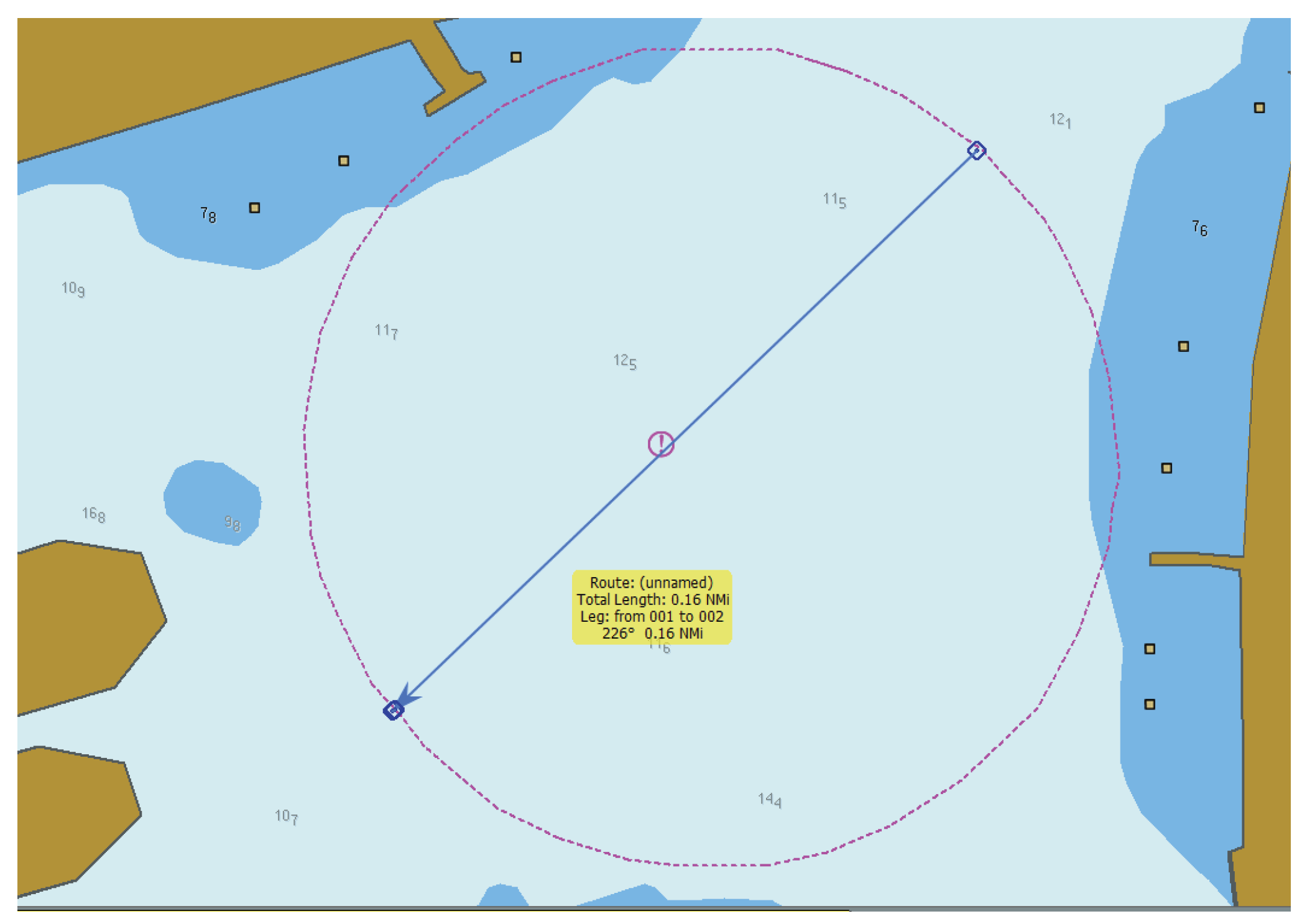Submitted:
21 February 2024
Posted:
22 February 2024
You are already at the latest version
Abstract
Keywords:
1. Introduction
2. Ships turning in ports situation and literature analysis
3. Theoretical justification of turning ships in port turning basins with low clearance
3.1. Steps of research methodology
3.2. Mathematical model
 experiments on real ships results).
experiments on real ships results).4. 4. Case study of the ship‘s turning in port ships turning basin.
 experiments on real ships results), depending on the clearance, using two 500 kN tugs, presented in Figure 9.
experiments on real ships results), depending on the clearance, using two 500 kN tugs, presented in Figure 9.  experiments on real ships results) (figure 10).
experiments on real ships results) (figure 10). experiments on real ships results) (figure 11).
experiments on real ships results) (figure 11).  experiments on real ships results).
experiments on real ships results).  experiments on real ships results).
experiments on real ships results).  experiments on real ships results).
experiments on real ships results).  ,
,  experiments on real ships results).
experiments on real ships results).5. Discussions and conclusions
Author Contributions
Funding
Institutional Review Board Statement
Informed Consent Statement
Data Availability Statement
Acknowledgments
Conflicts of Interest
References
- Coldwell, T.G. Marine traffic behavior in restricted waters. J. Navig. 1983, 36, 430–444. Consumption and Emissions. Appl. Sci. 2023, 13, 5582. [Google Scholar] [CrossRef]
- Szlapczynski, R.; Szlapczynska, J. Review of ship safety domains: Models and applications. Ocean Eng. 2017, 145, 277–289. [Google Scholar] [CrossRef]
- Paulauskas, V.; Paulauskas, D. Ship’s steering in port areas. Klaipeda University publish house, Klaipeda, 2009, 256 p. (LT).
- Bellsolà Olba, X.; Daamen, W.; Vellinga, T.; Hoogendoorn, S.P. Risk Assessment Methodology for Vessel Traffic in Ports by Defining the Nautical Port Risk Index. J. Mar. Sci. Eng. 2020, 8, 1. [Google Scholar] [CrossRef]
- Eleftheria, E.; Apostolos, P.; Markos, V. Statistical analysis of ship accidents and review of safety level. Saf. Sci. 2016, 85, 282–292. [Google Scholar]
- Gdansk port. www.portofgdansk.pl (Accessed: 25.01.2024).
- Ventspils port. www.portofventspils.lv (Accessed 25.01.2024).
- Pelic, V.; Ozren, B.; Radonja, R.; Degiuli, N. The Impact of Slow Steaming on Fuel Consumption and CO2 Emissions of a Container Ship. J. Mar. Sci. Eng. 2023, 11, 675. [Google Scholar] [CrossRef]
- Di Vaio, A.; Varriale, L. Management innovation for environmental sustainability in seaports: Managerial accounting instruments and training for competitive green ports beyond the regulations. Sustainability 2018, 10, 783. [Google Scholar] [CrossRef]
- Kornacki, J.; Galor, W. Analysis of Ships Turn Maneuvers in Port Water Area. Int. J. Mar. Navig. Saf. Sea Transp. 2007, 1, 95–100. [Google Scholar]
- Heinrich, L.; Koschinsky, A.; Markus, T.; Singh, P. Quantifying the fuel consumption, greenhouse gas emissions and air pollution of a potential commercial manganese nodule mining operation. Mar. Policy 2020, 114, 103678. [Google Scholar] [CrossRef]
- Aydin, C.; Karabulut, U.C.; Ünal, U.O.; Sariöz, K. Practical computational procedures for predicting steering and braking forces of escort tugs. Gemive Deniz Teknol. 2017, 21, 21–36. [Google Scholar] [CrossRef]
- Chauvin, C.; Lardjane, S.; Morel, G.; Clostermann, J.P.; Langard, B. Human and organizational factors in maritime accidents: Analysis of collisions at sea using the HFACS. Accid. Anal. Prev. 2013, 59, 26–37. [Google Scholar] [CrossRef]
- Wu, B.; Yan, X.; Wang, Y.; Soares, C.G. An evidential reasoning-based cream to human reliability analysis in maritime accident process. Risk Anal. 2017, 37, 1936–1957. [Google Scholar] [CrossRef] [PubMed]
- Corrigan, S.; Kay, A.; Ryan, M.; Ward, M.E.; Brazil, B. Human factors and safety culture: Challenges and opportunities for the port environment. Saf. Sci. 2019, 119, 252–265. [Google Scholar] [CrossRef]
- Endresen, Ø.; Sørgård, E.; Sundet, J.K.; Dalsøren, S.B.; Isaksen, I.S.A.; Berglen, T.F.; Gravir, G. Emission from international sea transportation and environmental impact. J. Geophys. Res. D Atmos. 2003, 108, ACH 14-1 ACH 14-22. [Google Scholar] [CrossRef]
- Paulauskas, V. Ships entering the ports. N.I.M.S. publish house, Riga, 2013, 240 p. ISBN: 9984-679-71-3.
- Piaggio, B.; Viviani, M.; Martelli, M.; Figari, M. Z-Drive Escort Tug maneuverability model and simulation. Ocean Eng. 2019, 191, 106461. [Google Scholar] [CrossRef]
- Theirs, G.F.; Jansses, G.K. A Port Simulation Model as a Performance Decision Instrument. Simulation 1998, 71, 117–125. [Google Scholar] [CrossRef]
- AIS; https://www.marinetraffic.com/en/ais/home/centerx:21.146/centery:55.656/zoom:15 (Accessed: 25.03.2023).
- Bojić, F.; Bošnjak, R.; Lušić, Z.; Gudelj, A. Methodology for the Development of Parameters for the Navigational Safety Risk Assessment Model in Port Approaches. TransNav, the International Journal on Marine Navigation and Safety of Sea Transportation, 2021, Vol. 15, No. 2, 365-370. [CrossRef]
- Bye Rolf, J. , Gilberg Asbjørn. (2018). Maritime navigation accidents and risk indicators: An exploratory statistical analysis using AIS data and accident reports. Reliab. Eng. Syst. Saf. 2018, 176, 174–186. [Google Scholar]
- Clume, S.F.; Belchior, C.R.P.; Gutiérrez, R.H.R.; Monteiro, U.A.; Vaz, L.A. Methodology for the validation of fuel consumption in diesel engines installed on board military ships, using diesel oil and biodiesel blends. J Braz Soc Mech Sci Eng 2019, 41, 516. [Google Scholar] [CrossRef]
- Heinrich, L.; Koschinsky, A.; Markus, T.; Singh, P. Quantifying the fuel consumption, greenhouse gas emissions and air pollution of a potential commercial manganese nodule mining operation. Mar. Policy, 2020, 114, 103678. [Google Scholar] [CrossRef]
- Lee, C.-K.; Moon, S.-B.; Jeong, T.-G. The investigation of ship maneuvering with hydrodynamic effects between ships in curved narrow channel. Int. J. Nav. Archit. Ocean. Eng. 2016, 8, 102–109. [Google Scholar] [CrossRef]
- Junjie Li, Xinyu Zhang, Bingdong Yang, Nannan Wang. Vessel traffic scheduling optimization for restricted channel in ports. Comput. Ind. Eng. 2021, 152. [Google Scholar] [CrossRef]
- Paulauskas, V.; Filina-Dawidowicz, L.; Paulauskas, D. Navigation of Ships in Channel Bends under Special Conditions Using Sensors Systems. Sensors 2022, 22, 8783. [Google Scholar] [CrossRef]
- Mou, J.M.; Chen, P.F.; He, Y.X.; Yip, T.L.; Li, W.H.; Tang, J.; Zhang, H.Z. Vessel traffic safety in busy waterways: A case study of accidents in western Shenzhen port. Accid. Anal. Prev. 2019, 123, 461–468. [Google Scholar] [CrossRef]
- Yıldırım, U.; Basar, E.; Ugurlu, Ö. Assessment of collisions and grounding accidents with human factors analysis and classification system (HFACS) and statistical methods. Saf. Sci. 2019, 119, 412–425. [Google Scholar] [CrossRef]
- PIANC, 2014. Harbor Approach Channels and Design Guidelines - Report No 121-2014, s.l.: The World Association for Waterborne Transport Infrastructure. Available on-line: http://marineman.ir/wp-content/uploads/2015/04/NAVIGATION-PIANC-Harbour-Approach-Channels-Design-Guidelines-2014.pdf (Accessed: 25 February 2023). 25 February.
- Puertos del Estado. 1999. ROM 3.1-99: Recommendation for Design of the Maritime Configuration of Ports, Approach Channels and Harbor Basins. Puertos del Estado [Ports of the State], Madrid, Spain. 382 p. Available from Internet: http://www. puertos.es/eu-es/BibliotecaV2/ROM%203.1-99%20(EN).pdf.
- Openseamap. https://map.openseamap.org/ (Accessed: 25.01.2024).
- “SimFlex Navigator” simulator, Force Technology, Denmark, license No 159.
- Klaipeda Seaport manual, maps and charts, 2024.
- Lisowski, J. Analysis of Methods of Determining the Safe Ship Trajectory. TransNav: International Journal on Marine Navigation and Safety of Sea Transportation, 2016, 10(2), 223–228. [CrossRef]
- Paulauskas, V.; Paulauskas, D.; Paulauskas, V. Impact of Port Clearance on Ships Safety, Energy Consumption and Emissions. Appl. Sci. 2023, 13, 5582. [Google Scholar] [CrossRef]
- Tadros M, Ventura M, Guedes Soares. Optimization procedure to minimize fuel consumption of a four-stroke marine turbocharged diesel engine. Energy 168(C), 2019, 897–908. [CrossRef]
- Molland, A.F.; Turnock, S.R.; Hudson, D.A. Ship Resistance and Propulsion. Practical Estimation of Propulsive Power. Cambridge University Press, 2011, 537 p. [CrossRef]
- Paulauskas, V.; Senčila, V.; Paulauskas, D.; Simutis, M. Impact of Port Shallowness (Clearance under the Ship’s Keel) on Shipping Safety, Energy Consumption and Sustainability of Green Ports. Sustainability 2023, 15, 15802. [Google Scholar] [CrossRef]
- Rawson K., J. , Tupper E.C. Basic Ship Theory (Fifth Edition). Elsever 2001, 727 p.
- Paulauskas, V.; Filina-Dawidowicz, L.; Paulauskas, D. The Method to Decrease Emissions from Ships in Port Areas. Sustainability 2020, 12, 4374. [Google Scholar] [CrossRef]
- Fan, S.; Zhang, J.; Blanco-Davis, E.; Yang, Z.; Wang, J.; Yan, X. Effects of seafarers’ emotion on human performance using bridge simulation. Ocean Eng., 2018, 170, 111–119. [Google Scholar] [CrossRef]
- Gucma, L. The risk assessment of ships maneuvering on the waterways based on generalized simulation data. Safety and Security Engineering II. WIT Transactions on the Built Environment, 2007, vol. 94, WIT Press. P. 58 – 69.
- Bitner-Gregerse, E.M.; Soares, C.G.; Vantorre, M. Adverse weather conditions for ship maneuverability. Transp. Res. Procedia 2016, 14, 1631–1640. [Google Scholar] [CrossRef]
- Quy, M.N.; Łazuga, K.; Gucma, L.; Vrijling, J.K.; van Gelder, P.H.A.J.M. Towards generalized ship’s maneuver models based on real time simulation results in port approach areas. Ocean. Eng. 2020, 209, 107476. [Google Scholar] [CrossRef]
- Nakamura, S. Study on Maneuvering Criteria for Safety Assessment in Shallow Water. TransNav: Int. J. Mar. Navig. Saf. Sea Transp. 2017, 11, 401–407. [Google Scholar] [CrossRef]
- Paulauskas, V.; Simutis, M.; Plačiene, B.; Barzdžiukas, R.; Jonkus, M.; Paulauskas, D. The Influence of Port Tugs on Improving the Navigational Safety of the Port. J. Mar. Sci. Eng. 2021, 9, 342. [Google Scholar] [CrossRef]
- Zheng, Y. Trajectory data mining: An overview. ACM Trans. Intell. Syst. Technol. 2015, 6, 1–41. [Google Scholar] [CrossRef]
- Lack, D.A.; Corbett, J.J. Black carbon from ships: A review of the effects of ship speed, fuel quality and exhaust gas scrubbing. Atmos. Chem. Phys. 2012, 12, 3985–4000. [Google Scholar] [CrossRef]
- Hanqing, J,, Shige, P. Optimal unbiased estimation for maximal distribution. American Institute of Mathematical Science, 2021, Volume 6, Issue 3: P. 189-198. [CrossRef]
- Asbjørn Lein, Aalberg Rolf, Johan Bye Peter, Risberg Ellevseth. Risk factors and navigation accidents: A historical analysis comparing accident-free and accident-prone vessels using indicators from AIS data and vessel databases 2020. Maritime Transport Research 3, 2022, 100062, 17. [CrossRef]
- Lion, S.; Vlaskos, I.; Taccani, R. A review of emissions reduction technologies for low and medium speed marine Diesel engines and their potential for waste heat recovery. Energy Convers. Manag., 2020, 207, 112553. [Google Scholar] [CrossRef]
- Raymond A. Serway (1986). Physics for Scientists and Engineers (2nd ed.). Saunders College Publishing. p. 202. ISBN 0-03-004534-7.
- S.S. Kianejad, Hossein Enshaei, Jonathan Duffy, Nazanin Ansarifard. Prediction of a ship roll added mass moment of inertia using numerical simulation. Ocean Engineering Volume 173, 1 February 2019, Pages 77-89.
- M. A. Kalam, M. Husnawan ∗, H.H. Masjuki. Exhaust emission and combustion evaluation of coconut oil-powered indirect injection diesel engine. Renewable Energy. 2003, 28, 2405–2415. [Google Scholar] [CrossRef]
- IMO, Amendments to the Annex of the Protocol of 1997 to Amend the International Convention for the Prevention of Pollution from Ships, 1973, as Modified by the Protocol of 1978 Relating thereto (MARPOL Annex VI), 2008. Available online: http://www.imo.org/includes/blastDataOnly.asp/data_id%3D23760/ 176 (accessed on 25 May 2020).
- Brynolf, S., Fridell, E., & Andersson, K. (2014). Environmental assessment of marine fuels: Liquefied natural gas, liquefied biogas, methanol and bio-methanol. Journal of Cleaner Production, 74, 86–95.
- IMO. Marine Engine Regulations; IMO: London, UK, 2015. [Google Scholar]
- Chauhan, S.; Patil, C.; Sinha, M.; Halder, A. Fuzzy state noise-driven Kalman filter for sensor fusion. Proc. Inst. Mech. Eng. Part. G J. Aerosp. Eng. 2009, 223, 1091–1097. [Google Scholar] [CrossRef]

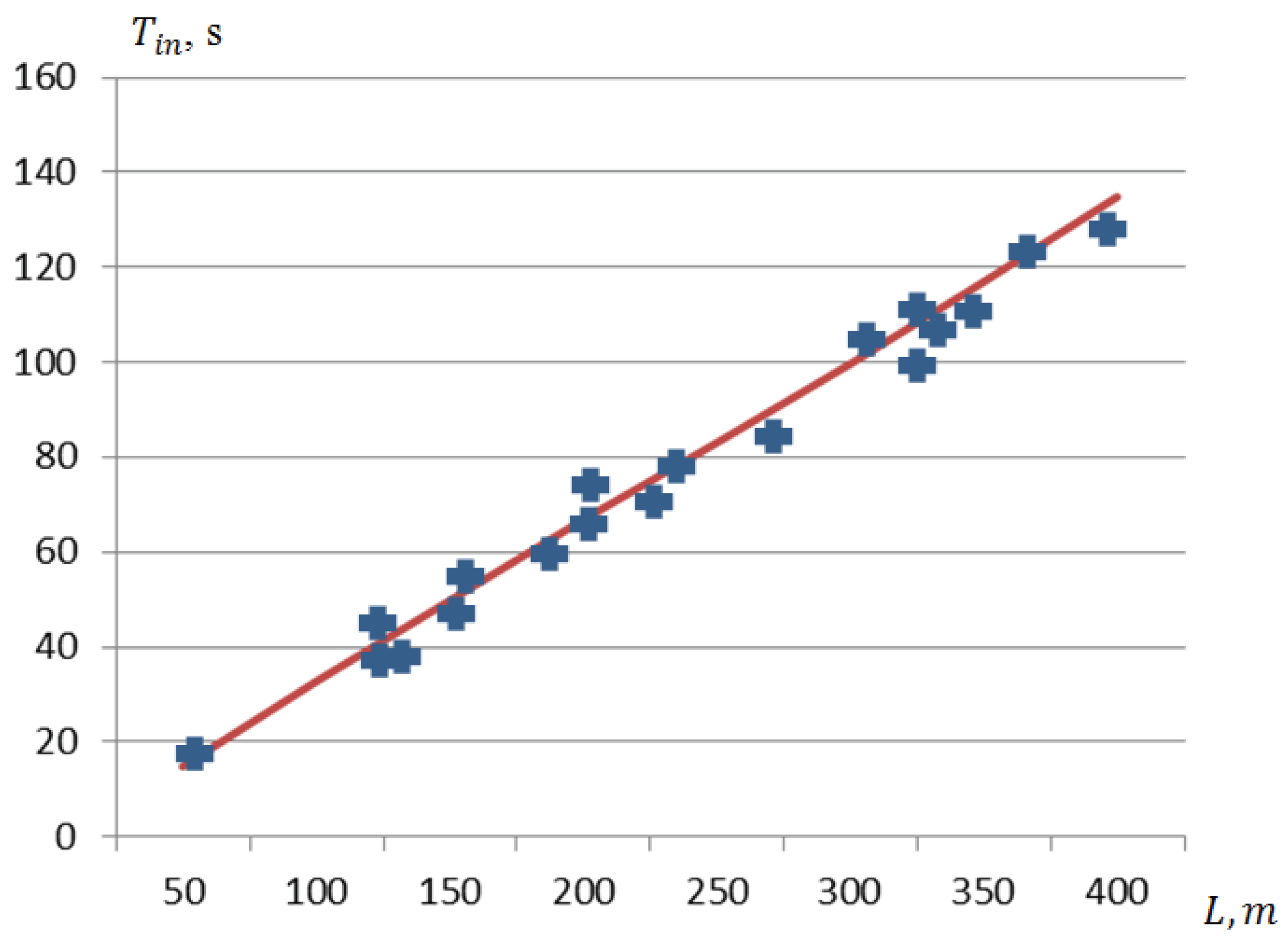
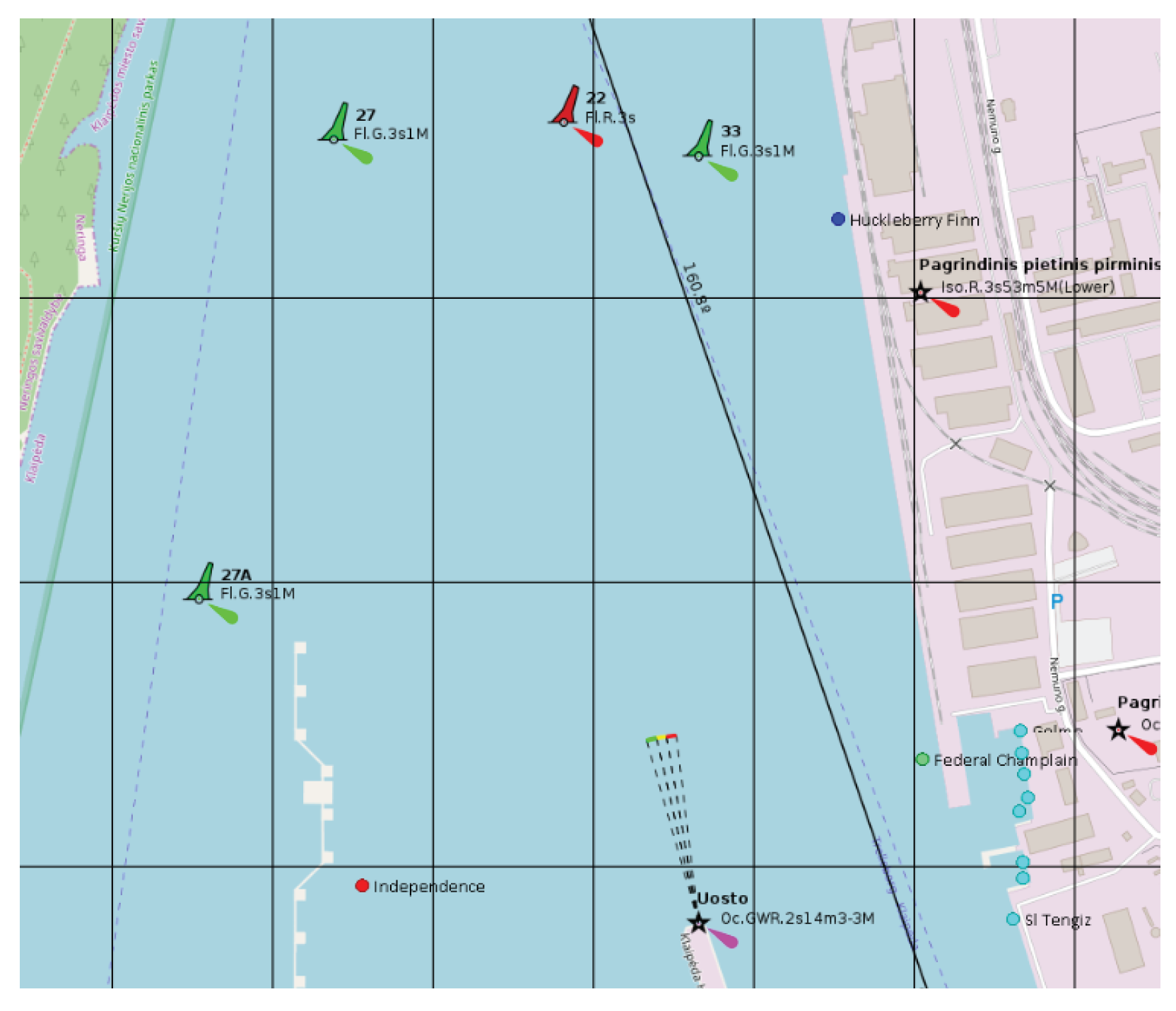

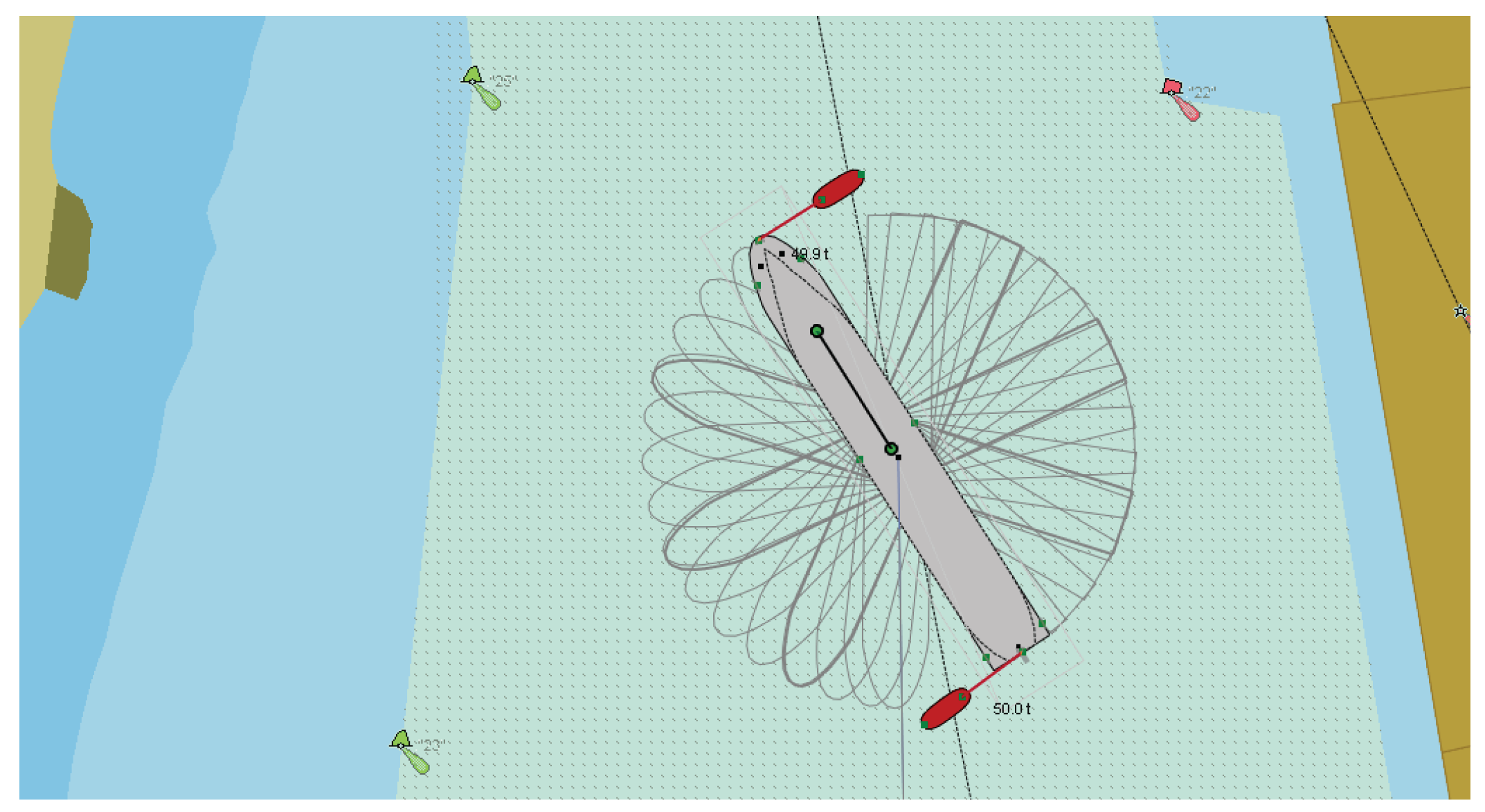
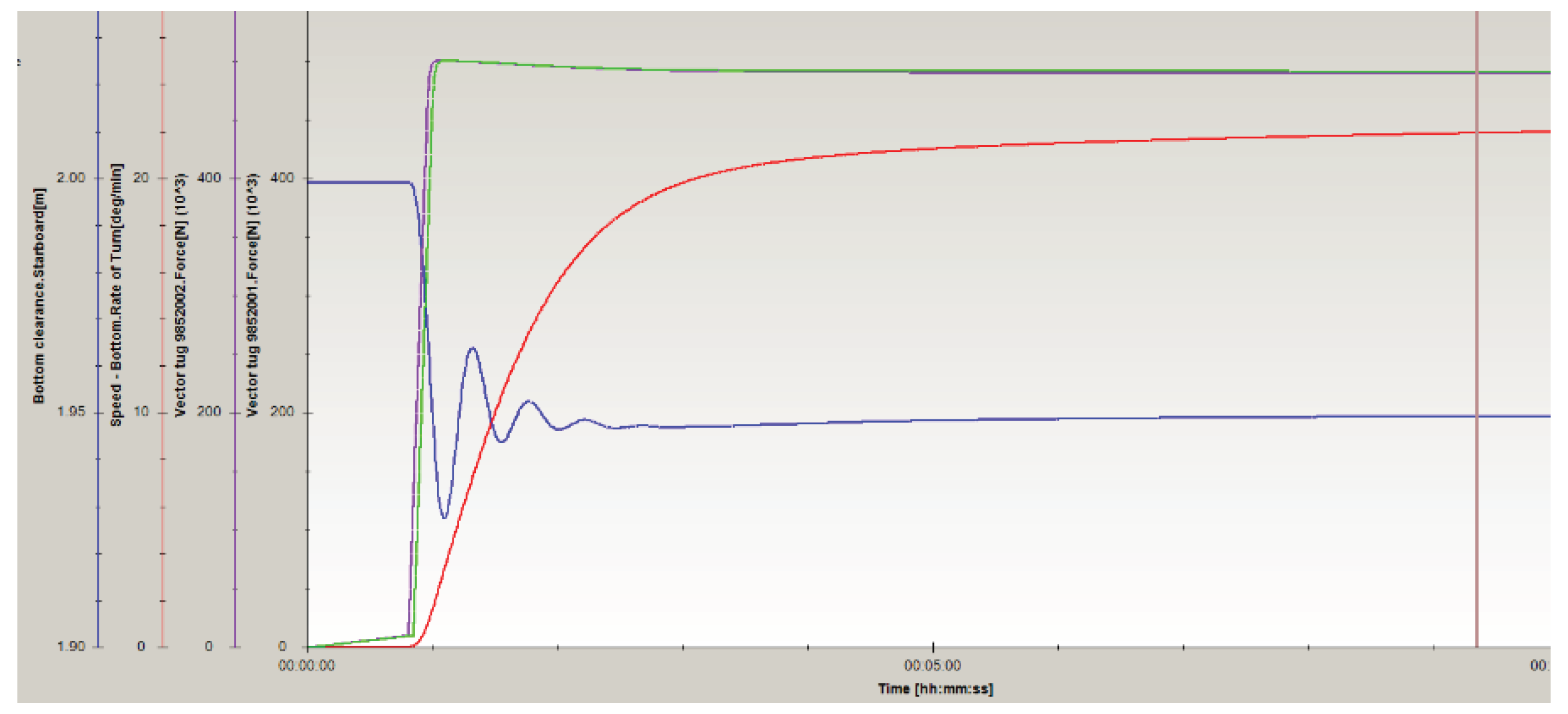




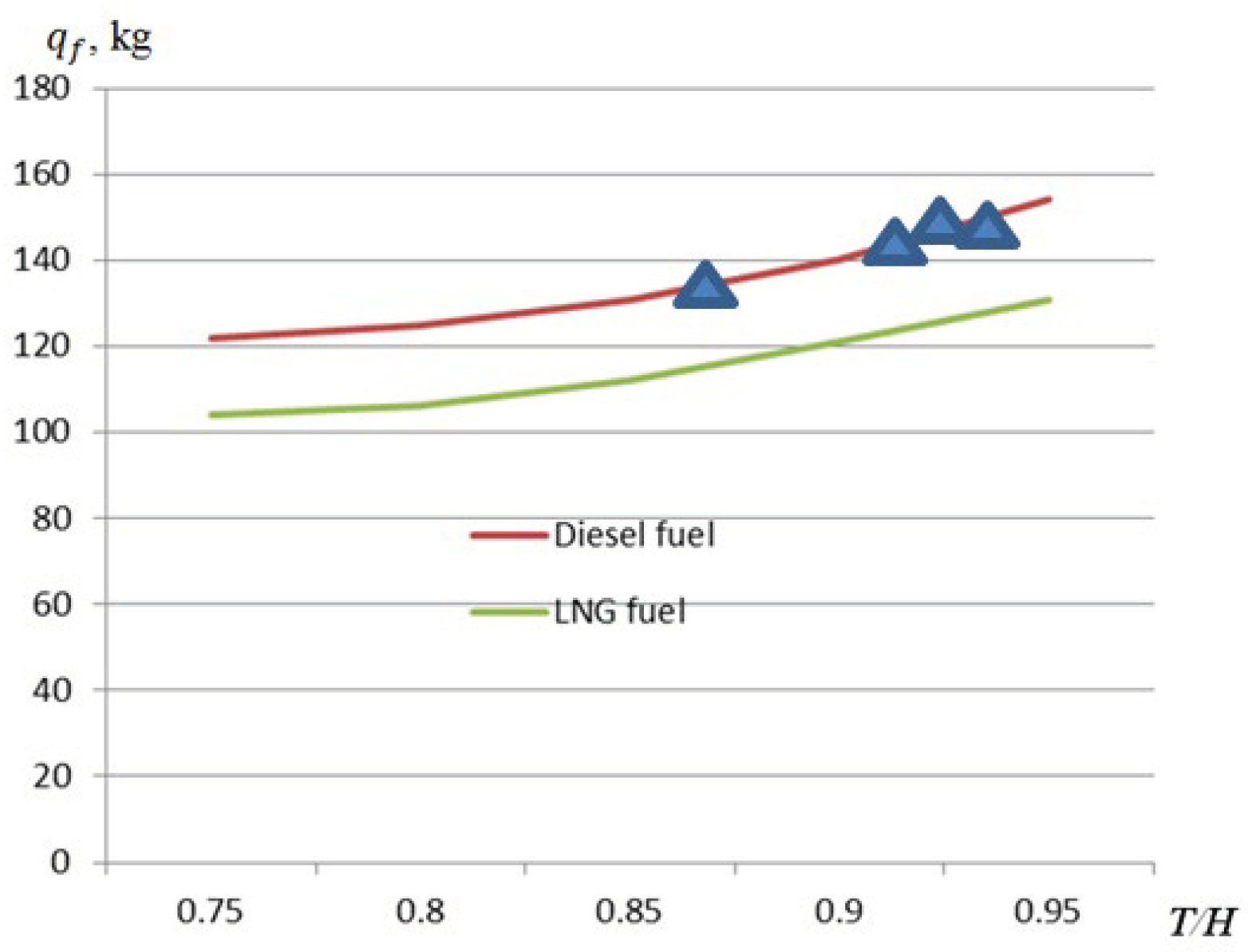
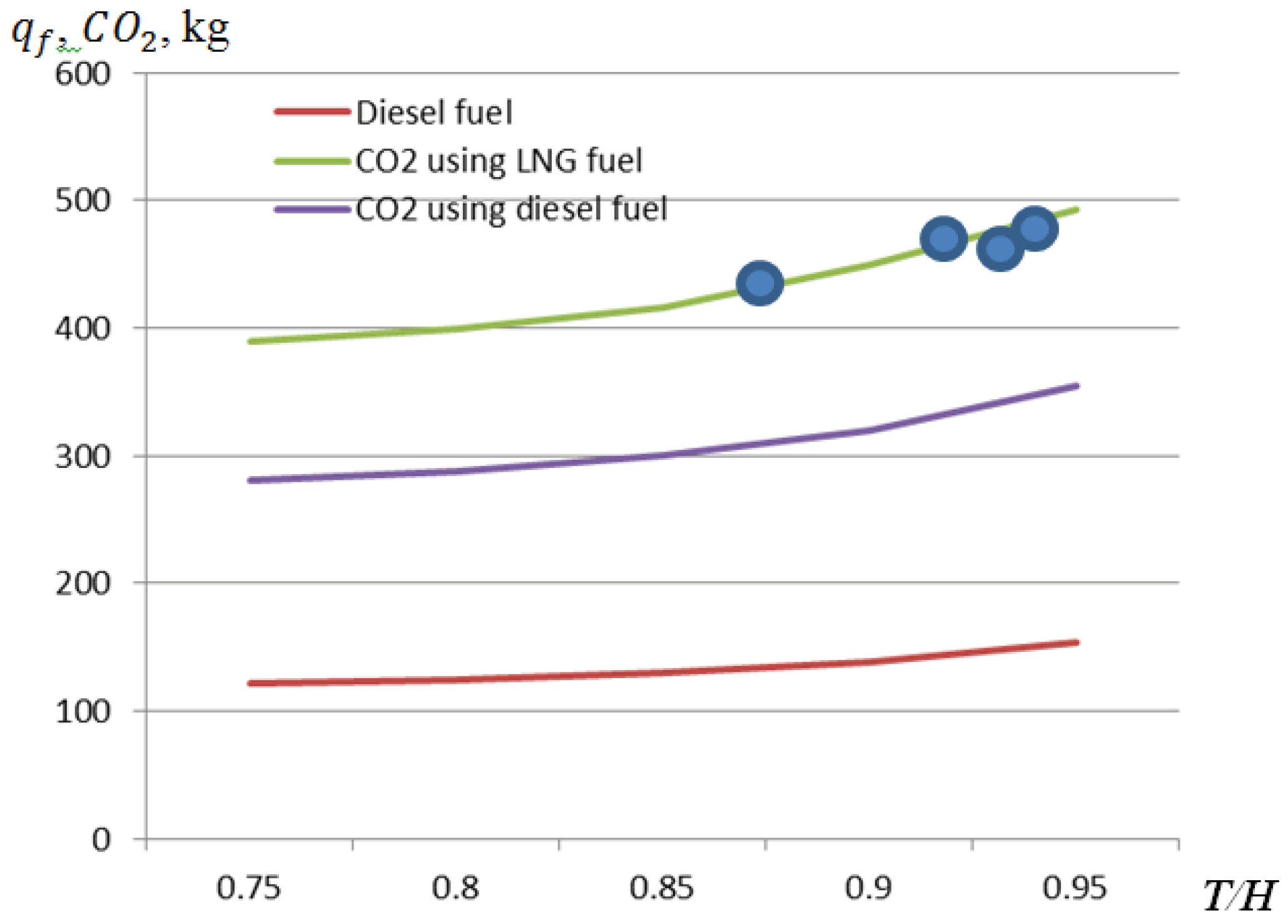

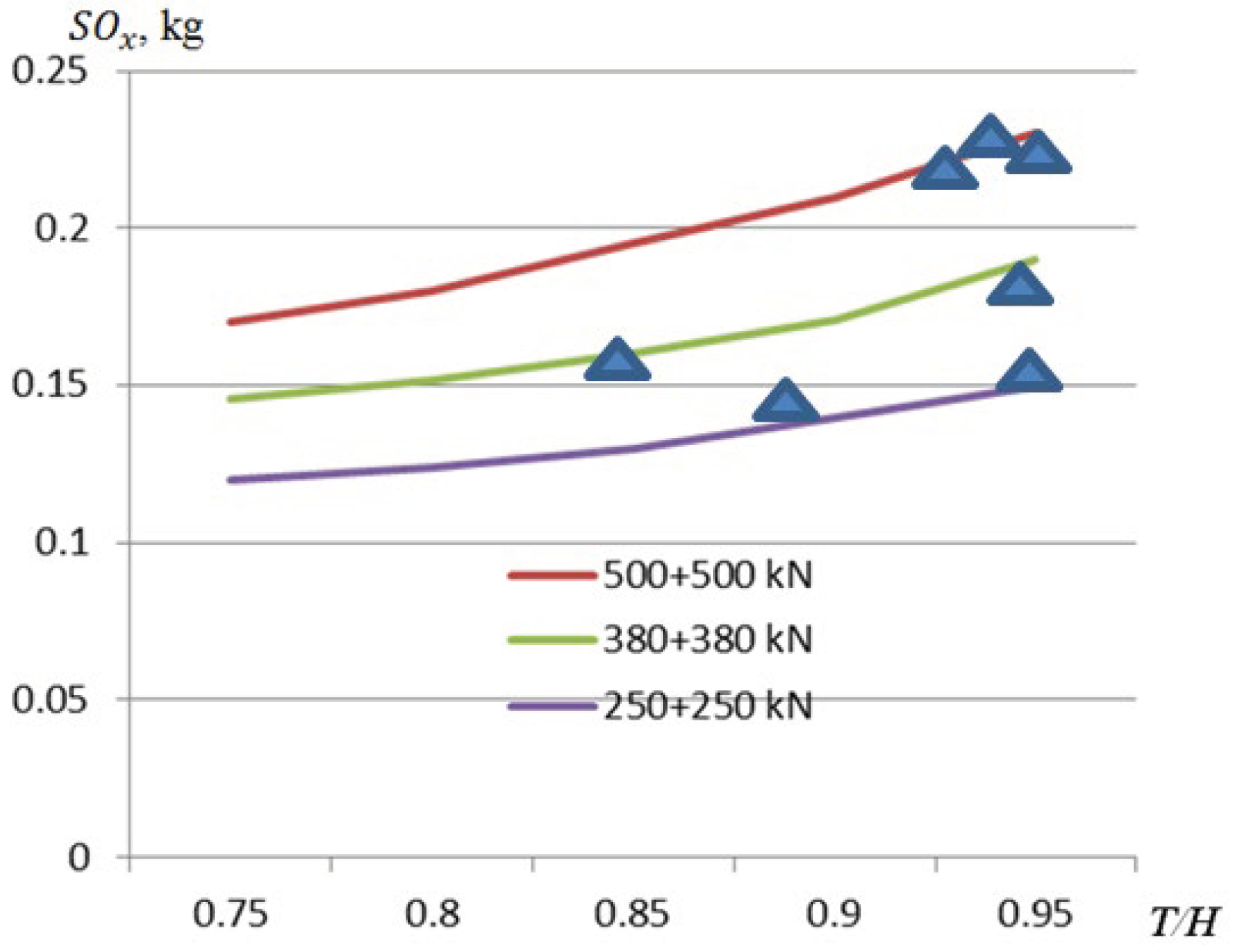
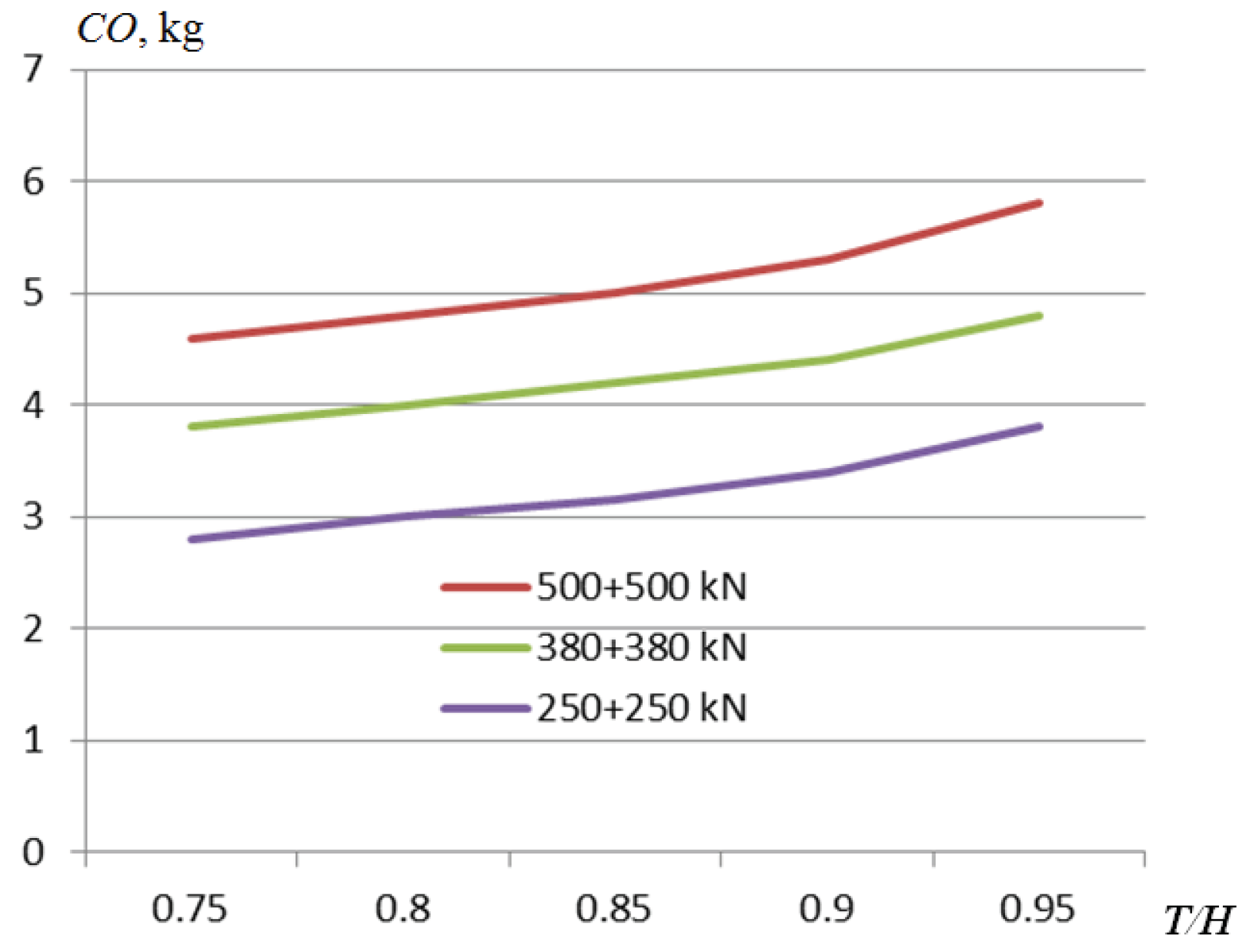
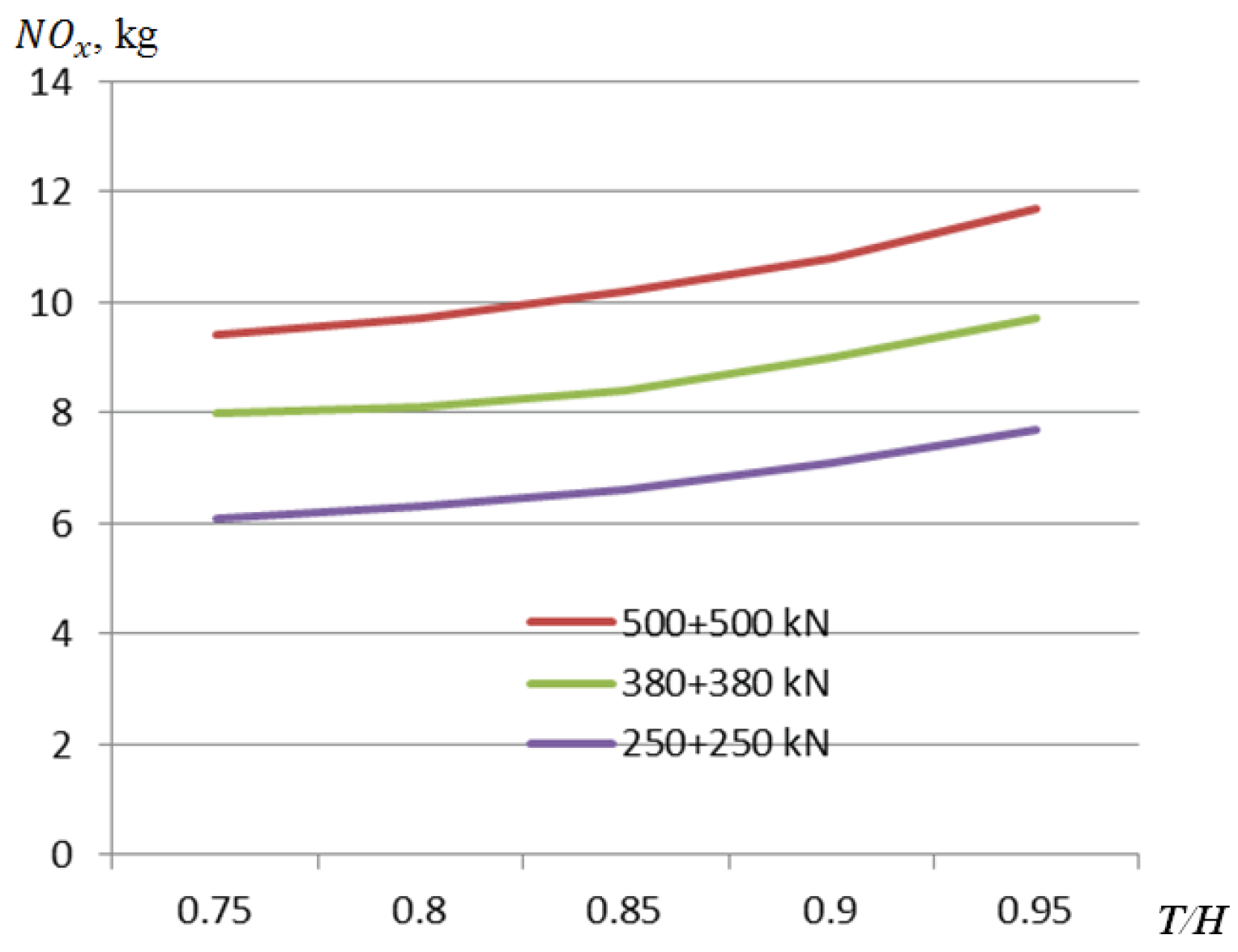

Disclaimer/Publisher’s Note: The statements, opinions and data contained in all publications are solely those of the individual author(s) and contributor(s) and not of MDPI and/or the editor(s). MDPI and/or the editor(s) disclaim responsibility for any injury to people or property resulting from any ideas, methods, instructions or products referred to in the content. |
© 2024 by the authors. Licensee MDPI, Basel, Switzerland. This article is an open access article distributed under the terms and conditions of the Creative Commons Attribution (CC BY) license (http://creativecommons.org/licenses/by/4.0/).
